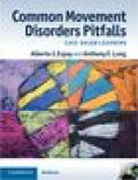
Common movement disorders pitfalls: case-based learning
Espay, Alberto J.
Lang, Anthony
The many powerful lessons in this case-based book convey clinical pearls ondiagnostic or therapeutic issues in movement disorders. The many powerful lessons in this case-based book will help readers appreciate movement disorders diagnoses missed, movements difficult to characterize, tests inappropriately interpreted, and treatments incorrectly chosen. Organized in nine chapters, eachcase conveys a specific set of clinical pearls on diagnostic or therapeutic issues. The many powerful lessons in this case-based book will help readers appreciate movement disorders diagnoses missed, movements difficult to characterize, tests inappropriately interpreted, and treatments incorrectly chosen. Organized in nine chapters, each case conveys a specific set of clinical pearls ondiagnostic or therapeutic issues. Visual observation of patients is crucial in the diagnosis of movement disorders. Such observation can be subject to manypitfalls. The powerful lessons in this case-based book will help the reader appreciate diagnoses missed or wrongly attributed, movements difficult to characterize, tests inappropriately ordered or interpreted, and treatments incorrectly chosen or dosed. The wisdom of hindsight thus generated becomes an invaluable and enduring lesson. Organized in nine chapters according to the categories of errors and oversights, each case conveys a specific set of clinical pearls on diagnostic or therapeutic issues. The text is written in a coaching style, buttressed by the strong pedagogic wisdom of the authors. The 'hard questions' after each case are meant to steer the discussion straight into the pitfalls - and how they could have been avoided. Video segments on the accompanying CD-ROM are important complementary data, critical to a field so intimately dependent on phenomenological clues. INDICE: Preface; 1. Missing the diagnosis altogether; 2. Attributing findings to a known or suspected disorder; 3. Clinical findings that are subtle; 4.When movement disorders are difficult to characterize; 5. Over-reliance on negative test results; 6. Failure of pattern recognition; 7. Testing pitfalls ofcommission or omission; 8. Missing radiographic clues; 9. Management misadventures; Further reading; Appendix: video legends; Index.
- ISBN: 978-0-521-14796-5
- Editorial: Cambridge University
- Encuadernacion: Rústica
- Páginas: 138
- Fecha Publicación: 15/03/2012
- Nº Volúmenes: 1
- Idioma: Inglés
